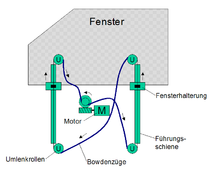Window regulator
Window regulators are technical devices that are used to raise and lower hinged windows, car windows or other openings.
In automotive engineering
Emergence
The first windows in automobile construction were fixed or pluggable, used first in the front area and later also in the side area. A further development were front windows that could be folded down using hinges. The last stage of development before the use of window regulators commonly used today were hinged windows (in the side area). In addition, sliding windows were also common, e.g. B. Renault 4 . Top- hung or sliding windowhave two advantages: they are cheaper and water cannot get into the door. The seal on the lower edge of a vertically movable window is not completely tight; when it rains or when washing the car, a certain amount of water can get into the door. Therefore, water drains must be installed on the underside of the door. However, if these are clogged or if the vehicle is not level, water collects there and can lead to corrosion .
In the automobile (mechanical)

The entrepreneur Max Brose manufactured crank window regulators for the first time in 1928.
The use of the wrap spring brake , patented in 1926 , made it possible for the first time to hold the vehicle window in any position. At that time they were called crank apparatus and sold under the brand name "Atlas". Customers were u. a. Daimler-Benz , Volkswagen , Borgward and Lloyd .
In the automobile (electric)
In the USA, electrically operated window regulators were introduced in a Lincoln as early as 1941 .
The first European vehicle with power windows was the BMW 503 ; it was produced from 1956 to 1960.
Today, electric window regulators are predominantly installed in almost all vehicle classes. Typically, an individual button is attached to each door panel . Another set of buttons is located in the driver's door so that the driver can operate all windows. In some car models, the central set of buttons is located in the center console, where it can also be reached by the front passenger.
functionality
In electric window regulators that work with cables, an electric motor drives a cable drum via a worm gear / spur gear . The two ends of a steel cable are attached to this in such a way that one end is wound up and the other unwound when it is turned. The pull rope pulls window attachments running on two guide rails via a Bowden cable and pulleys; the rope end without tension is wound back onto the rope drum. The ends of the two Bowden cable sheaths are resiliently held on the housing of the drive in order to bring a certain flexibility into the system. However, other systems are also in use.
Anti-trap protection
Simple systems implement anti-trap protection partly mechanically via slip or friction clutches . In the case of more complex or comfortable window regulators with an automatic closing function ("comfort closing" etc.), it is important that anti-trap protection is in place: As soon as the drive torque for closing the window exceeds a certain limit, depending on the window position, the direction of movement of the window must be reversed in order to to release the supposed obstacle again. The anti-trap protection must determine via the position of the window whether there is an obstacle or the window has reached the rubber seal at the end position. The anti-jamming function is usually implemented by electronics attached directly to the motor , as the window position on the motor axis can simply be measured using Hall sensors .
In the picture you can see the opened drive unit with drive motor and worm gear on the right side. On the axis of the spur gear there is a small cable drum (not shown in the picture) on which the actuating Bowden cable is wound. In the left half of the picture you can see the control electronics, which also contact the motor, determine the window position based on the number of motor revolutions and implement the anti-trap protection.
In greenhouses, cold frames, etc.
Purely mechanical window regulators are often used here, mostly in connection with hinged windows. These have a lever mechanism and can be lifted using rods and / or joint systems and fixed in the desired position using notches or a slip clutch .
In the case of partial automation (on a mechanical basis), the rods are moved by pistons which are inserted into a cylinder filled with liquid or gas. The cylinder contents expand when heated and contract when cooled, causing the piston to move in or out. This ensures that the window opens when it is warm and closes when it is cold.
When using electric windows, these can be, for. B. driven by an electric motor that raises or lowers the window via gears and rack. With such systems all possibilities of automation can be realized.
literature
- Hans-Hermann Braess, Ulrich Seiffert: Vieweg manual automotive technology. 2nd edition, Friedrich Vieweg & Sohn Verlagsgesellschaft mbH, Braunschweig / Wiesbaden, 2001, ISBN 3-528-13114-4
- Karl-Heinz Dietsche, Thomas Jäger, Robert Bosch GmbH: Automotive pocket book. 25th edition, Friedr. Vieweg & Sohn Verlag, Wiesbaden, 2003, ISBN 3-528-23876-3
swell
- History, development of wrap spring brakes by Brose, history 1919 and 1926
Web links
- Adjusting drives from Brose
- Door systems from kuester.net

